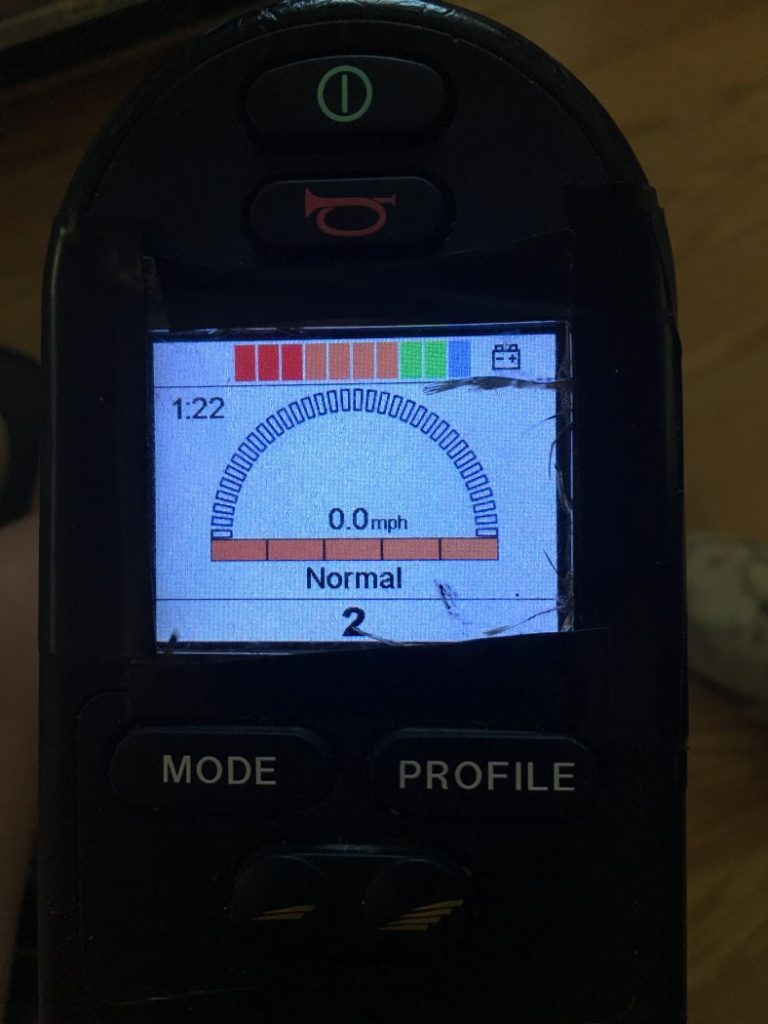Hurry Up and Stop: The Endless Counting of Batteries


The battery level on Ella’s power wheelchair
Flashing lights, beeping sounds, and a host of power in her little grip. The Permobile C300 is Ella’s power wheelchair. A 304-pound purple machine that provides her with mobility. The C300 has indicators that allow its drivers to know how much battery they have at any given moment (among other important “chair stats”).
The control panel uses lighted bars to indicate battery level; there are three red, four orange and three green lights on the display. Ella counts the bars and uses that number to determine her battery level. For example, if the display is at the second green she has “nine batteries” left. This is the part of the control panel that Ella pays close attention to, for to run out of battery is to run out of mobility. Then what?
When she first received her chair the battery easily would last an entire day. She might have seven or eight batteries by bedtime. It never was really a concern. As of late, however, we are noticing the battery is running low, much more quickly. Ella drives up to us and gives us a well-timed report.
“I have seven batteries left.”
“I have three batteries left.”
“I have ONE battery left!”
It’s when we get to the “one battery left” report that we start to get into “charging” mode (or Plan A).
This is how we handle the ‘one-battery-left’ scenario.
Depending where we are determines our course of action. At home it’s a simple fix:
- Grab a coloring book, an iPad, or some small toys.
- Bring the charger to the kitchen table, and hang out for an hour or so while the battery is replenished.
Out and about is a different story:
- Ella must become disciplined on her use of the chair; ascertaining speed, ground level (in terms of hills and grades) and distances traveled.
- She must know when to turn off the chair to save battery life.
- She must make good decisions about whether to let a friend or sibling “catch a ride” from her.
- She must be decisive and discerning as to whether she uses the “tilt” and “raise” functions on her chair.
It’s a lot of responsibility for a 7-year old with SMA Type 2, but then again, she has a vested interest in keeping things moving.
If all else fails and she runs out of battery we go to Plan B: Disengage the brake and push her until we can get to the charger.
Not ideal for anyone, but it’s what must be done.
Some other ways to combat a less-than-fully-functional battery are if we know we are going somewhere then we give her chair an “extra boost charge” before leaving. Or, if we know we’ll be out for a while, we can take the charger with us and use the inverter in the modified van as a power source. (This way she can charge while we drive!) More and more though, “being prepared” is becoming the motto around here.
We’ve contacted our medical group for a referral to be submitted to our insurance company for a new battery, and wait on the red tape process. We check with Ella every so often and make sure the battery is fully charged at the onset of each day, and try not to weigh down the chair with unnecessary “luggage.”
In the meantime; we hurry up and stop.
***
Note: SMA News Today is strictly a news and information website about the disease. It does not provide medical advice, diagnosis, or treatment. This content is not intended to be a substitute for professional medical advice, diagnosis, or treatment. Always seek the advice of your physician or other qualified health provider with any questions you may have regarding a medical condition. Never disregard professional medical advice or delay in seeking it because of something you have read on this website. The opinions expressed in this column are not those of SMA News Today, or its parent company, Bionews Services, and are intended to spark discussion about issues pertaining to spinal muscular atrophy.








Leave a comment
Fill in the required fields to post. Your email address will not be published.